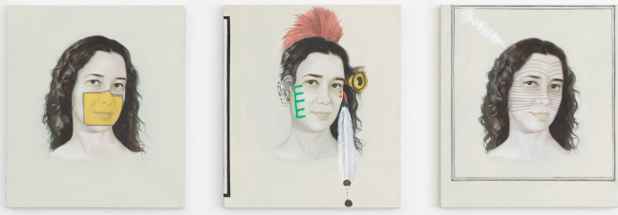Adriana Varejão “Kindred Spirits”
Lehmann Maupin (201 Chrystie Street)

This event has ended.
Lehmann Maupin present Kindred Spirits, renowned Brazilian artist Adriana Varejão’s sixth solo exhibition with the gallery. Varejão will include works from her two most recent series: Kindred Spirits, 29 portraits of the artist donning the face painting and body ornamentation of Native American tribes intermixed with markings derived from artworks by Minimalist and contemporary American artists, and the Mimbres paintings, which reference the visual culture of the Mimbres people who inhabited the American Southwest in the 11th century. Together these bodies of work elaborate on Varejão’s longstanding interest in colonialism’s effect on the aesthetics of identity.
Regarded as one of Brazil’s most accomplished contemporary artists, Varejão often references cultural and historic research through an intense investigation into anthropology, colonial trade, demography, and racial identity. She is especially influenced by theories of mestizaje (a term for the mixing of ancestries) and cultural anthropophagy—as proposed by the Brazilian poet Oswald de Andrade, who urged artists to “cannibalize,” rather than reject, cultural components of their country’s colonizers. The idea of empowering oppressed peoples through the assimilation of outside influences is reinforced through Varejão’s mixture of global artistic mediums and styles. Her approach has resulted in a diverse body of work that can be both humorous and grotesque in its assessment of humankind’s history of coexistence.
This exhibition serves as a continuation of the artist’s 2015 solo exhibition at the Dallas Contemporary, in which Varejão looked to art history—both Native American as well as within the Western canon—for inspiration, producing a tableau that reinterprets the Eurocentric perspective of the New World. In viewing the Mimbres and Kindred Spirits series together, Varejão demonstrates how Native American approaches to line, color, and shape influenced 20th century art, especially Minimalism. Both bodies of work weave together stories of distinct artistic traditions to emphasize the constant evolution and exchange of influences that shape culture and identity.
In searching for imagery of Native American face painting, Varejão was lead to the work of 19th century portraiture artists such as George Catlin, Charles Bird King, and Henry Inman, as well as the photographer and ethnologist Edwards Curtis, who captured their subjects in full ceremonial dress. Inman who never met a Native American, but copied the portraits painted by King, is widely referenced in the Kindred Spirits series.* The portraits of Varejão present the artist in identical three-quarter profile view. Each repeated image is distinguished by ornate tribal markings, indigenous headdress, and references to artists from Minimalists such as Sol Lewitt and Agnes Martin to contemporary artists including Paul Thek and Llyn Foulkes. Varejão was inspired by a 2012 book, also titled Kindred Spirits, which elaborates on the connections between Native American visual culture and the work of modern and contemporary artists. The artworks highlight the amalgamation of cultural identities that began with colonialism and continues through modern globalization.
The Mimbres series elaborates on a touchstone of Varejão’s practice: azulejões, paintings influenced by the hand-painted ceramic tiles dating to the 17th and 18th century that were brought to Brazil from Portugal, as well as 11th century cracked Song Dynasty pottery from China. Pedro Alonzo, curator of Varejão’s exhibition at the Dallas Contemporary, further describes the significance of the Mimbres culture’s pottery within the context of Varejão’s azulejões:
In the 1990s, Varejão began a series of crackled paintings based on 11th century Song Dynasty pottery from China. These monochromatic works featured the celadon colors—light green to light blue—emblematic of Chinese pottery. Resembling parched earth, the characteristic cracks were the product of aesthetic experimentation by Chinese master ceramicists who intentionally fired the pottery to the point of distress, resulting in the highly valued accidental cracks running through the pottery. Varejão’s new body of monochromatic, crackled works is inspired by 11th century Mimbres pottery from what is now the southwestern United States. Mimbres pottery is highly prized because of the sophisticated designs and figuration depicting daily life in the region. In Mimbres culture, the pottery was broken as part of an early burial rite and interred with the dead. It is thought that the pottery was broken to release the spirit of the vessel. The new crackled paintings feature earthy colors associated with Mimbres culture and the Southwest. The edges of Varejão’s canvases are adorned with Mimbres pottery designs composed of wavy lines forming scrolls, straight unbounded lines, and hachures.
Varejão and Alonzo will be in conversation at the gallery at 201 Chrystie Street on Friday, April 22 at 5PM. The talk is free and open to the public.
Following her exhibition at Lehmann Maupin, Varejão’s work will be prominently featured during the 2016 Summer Olympics in Rio de Janeiro, in the form of a large-scale commission for the Olympic Aquatics Stadium.
*Pedro Alonzo text, Dallas Contemporary, 2015.
Adriana Varejão (b. 1964) has exhibited extensively internationally, including solo exhibitions at the Dallas Contemporary (2015); The Institute of Contemporary Art, Boston (2014); Museu de Arte Moderna do Rio de Janeiro (2013); Museu de Arte Moderna de São Paulo (2012); Hara Museum, Japan (2007); and Fondation Cartier pour l’art contemporain, Paris (2005). Varejão’s work was included in the 12th International Istanbul Biennial (2011); Liverpool Biennial (1999 and 2006); SITE Santa Fé (2004); Sydney Biennial (2001); Mercosul Biennial in Visual Art, Brazil (1997, 2005, and 2015); and São Paulo Bienial (1994 and 1998), among others. Varejão’s work is included in the permanent collections of the Metropolitan Museum of Art, New York; the Tate Modern, London; Solomon R. Guggenheim Museum, New York; Hara Museum, Tokyo; Stedelijk Museum, Amsterdam; and Museum of Contemporary Art San Diego, among others. In 2008, the Centro de Arte Contemporânea Inhotim opened a permanent pavilion devoted to her work in Brazil. The artist lives and works in Rio de Janeiro, Brazil.
Media
Schedule
from April 21, 2016 to June 19, 2016
Opening Reception on 2016-04-21 from 18:00 to 20:00